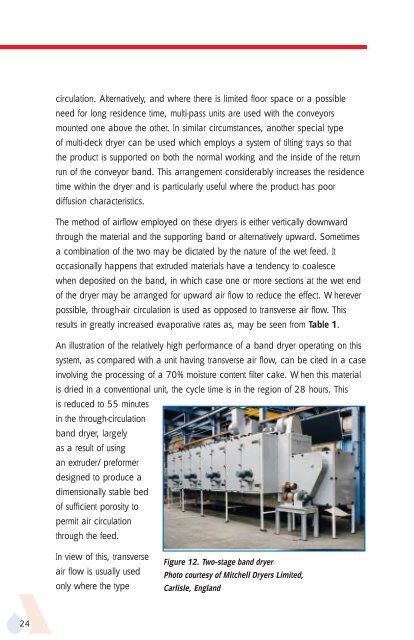APV Dryer Handbook - Umbc
APV Dryer Handbook - Umbc
APV Dryer Handbook - Umbc
You also want an ePaper? Increase the reach of your titles
YUMPU automatically turns print PDFs into web optimized ePapers that Google loves.
24<br />
circulation. Alternatively, and where there is limited floor space or a possible<br />
need for long residence time, multi-pass units are used with the conveyors<br />
mounted one above the other. In similar circumstances, another special type<br />
of multi-deck dryer can be used which employs a system of tilting trays so that<br />
the product is supported on both the normal working and the inside of the return<br />
run of the conveyor band. This arrangement considerably increases the residence<br />
time within the dryer and is particularly useful where the product has poor<br />
diffusion characteristics.<br />
The method of airflow employed on these dryers is either vertically downward<br />
through the material and the supporting band or alternatively upward. Sometimes<br />
a combination of the two may be dictated by the nature of the wet feed. It<br />
occasionally happens that extruded materials have a tendency to coalesce<br />
when deposited on the band, in which case one or more sections at the wet end<br />
of the dryer may be arranged for upward air flow to reduce the effect. Wherever<br />
possible, through-air circulation is used as opposed to transverse air flow. This<br />
results in greatly increased evaporative rates as, may be seen from Table 1.<br />
An illustration of the relatively high performance of a band dryer operating on this<br />
system, as compared with a unit having transverse air flow, can be cited in a case<br />
involving the processing of a 70% moisture content filter cake. When this material<br />
is dried in a conventional unit, the cycle time is in the region of 28 hours. This<br />
is reduced to 55 minutes<br />
in the through-circulation<br />
band dryer, largely<br />
as a result of using<br />
an extruder/preformer<br />
designed to produce a<br />
dimensionally stable bed<br />
of sufficient porosity to<br />
permit air circulation<br />
through the feed.<br />
In view of this, transverse<br />
air flow is usually used<br />
only where the type<br />
Figure 12. Two-stage band dryer<br />
Photo courtesy of Mitchell <strong>Dryer</strong>s Limited,<br />
Carlisle, England











